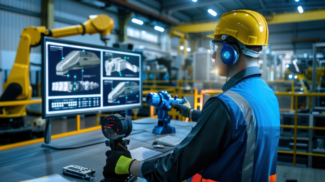Greetings! I'm Aneesh Sreedharan, CEO of 2Hats Logic Solutions. At 2Hats Logic Solutions, we are dedicated to providing technical expertise and resolving your concerns in the world of technology. Our blog page serves as a resource where we share insights and experiences, offering valuable perspectives on your queries.
Quick Summary
This blog highlights practical examples of computer vision in everyday life and how this technology quietly supports daily tasks and industries. From improving healthcare and retail experiences to enabling automation and smarter decision-making, discover how computer vision in AI is shaping the modern world.
Have you ever wondered how traffic cameras catch drivers not wearing their seat belts or how your phone automatically unlocks when it recognizes your face? These moments might seem like magic, but they’re all powered by computer vision. It is a fascinating branch of artificial intelligence (AI) that enables machines to see, understand, and respond to the world around them.
In simple terms, computer vision enables computers to interpret images and videos more accurately and continuously. From social media filters to visual search tools in e-commerce to computer vision, it’s all around us.
This blog explores some of the most exciting and practical applications of computer vision. This shows how this AI-driven technology quietly makes modern life smarter, safer, and more convenient.

Example 1 : Traffic Cameras and Road Safety
If you’ve ever received a message or a fine for not wearing your seat belt or crossing a red light, you’ve already experienced computer vision in daily life. Modern traffic cameras use AI vision technology to analyze video footage. This detects rule violations such as speeding, not wearing helmets, or using mobile phones while driving.
Here’s how it works:
- Cameras continuously capture footage of roads and intersections.
- Computer vision algorithms process each frame, identifying vehicles, license plates, and even driver behavior.
- When the system detects a violation, like a missing seat belt, it automatically captures the image, logs the data, and sends a report without human intervention.
This use of computer vision in AI not only improves road safety but also reduces the workload for law enforcement. It ensures consistent monitoring, 24/7, with minimal human error.
Pro Tip: Computer vision becomes even more powerful when paired with analytics. You can track patterns, behaviors, and performance visually to make smarter business decisions.
Example 2: Facial Recognition in Smartphones
Unlocking your phone with just a glance is one of the most common examples of computer vision in everyday life. Behind that instant face scan is a complex process where computer vision in AI maps and analyzes your facial features to verify your identity.
Here’s how it happens in seconds:
- Your phone’s front camera captures your face.
- Computer vision algorithms identify unique patterns, like the distance between your eyes, the shape of your jawline, and other distinguishing points.
- The system compares this with stored facial data, granting access only when it finds a match.
This technology is now used for secure app logins, digital payments, and even access control in offices. It’s a perfect example of AI vision technology enhancing both convenience and security in our daily routines.
Example 3: Visual Search in e-commerce
Have you ever taken a picture of a product and used it to find similar items online? That’s computer vision at work, making shopping more intuitive and personalized. Visual search in e-commerce uses AI vision technology to help customers find products faster, simply by uploading or snapping a photo.
Here’s how it works:
- The e-commerce platform’s computer vision algorithm analyzes the image you upload.
- It identifies visual features such as color, shape, texture, or brand markings.
- Then it instantly shows you similar or matching products from the store’s catalog.
This is one of the most practical examples of computer vision in everyday life, blending convenience with personalization.
Retailers also benefit from this technology. It improves user experience, increases conversion rates, and supports better product tagging and categorization. This helps stores manage their vast inventory more efficiently.
Get in Touch
Looking to automate your business with AI and computer vision?
Example 4: Social Media Filters and Tagging
Every time you use a dog-ear filter on Instagram or your phone automatically tags friends in a photo. That’s another fun and familiar example of computer vision in everyday life.
Social media platforms rely heavily on computer vision in AI to recognize faces, detect emotions, and apply filters in real time. The same technology is also behind automatic photo tagging, where the system identifies who’s in your picture by comparing facial features with existing profiles.
Here’s how it works:
- Computer vision algorithms analyze the pixels in an image to detect human faces and key landmarks (like eyes, nose, and mouth).
- Once detected, the system maps those points and applies AR effects or suggests tags.
- This process happens instantly, thanks to powerful AI vision technology.
Example 5: Healthcare and Medical Imaging
Imagine a doctor detecting diseases faster and more accurately, sometimes even before symptoms appear. That’s the power of computer vision in healthcare.
Hospitals and research centers use computer vision in AI to analyze medical images such as X-rays, CT scans, and MRIs. These systems can spot patterns or abnormalities that may go unnoticed by the human eye, assisting doctors in diagnosis and treatment planning.
Here’s how it works:
- Computer vision algorithms are trained on thousands of medical images.
- The AI learns to identify specific markers like tumors, fractures, or infections.
- It then highlights suspicious areas for doctors to review, improving both speed and accuracy.
Example 6: Self-Checkout and Retail Automation
Have you ever used an Amazon Go store or a supermarket self-checkout counter that doesn’t need a cashier? That is the example of computer vision in retail.
With computer vision in AI, cameras track what items you pick up and automatically add them to your virtual cart. When you walk out, payment is processed automatically.
In retail environments, computer vision algorithms can:
- Recognize products instantly, even without barcodes.
- Detect shelf stock levels and alert staff when items need restocking.
- Track customer movement to improve store layout and shopping experiences.
For online stores too, computer vision applications in e-commerce help automate product tagging, quality control, and even recommendation systems.
Example 7: Smart Cars and Traffic Systems
Computer vision in self-driving cars is one of the most advanced and visible real-world applications of AI today.
Cars equipped with computer vision systems use cameras and sensors to “see” their surroundings. This will help in identifying vehicles, road signs, traffic lights, and even unpredictable elements like cyclists or animals crossing.
Here’s what computer vision algorithms help with:
- Object detection: Recognizing nearby vehicles, pedestrians, and obstacles.
- Lane detection: Keeping the car centered and preventing lane departure.
- Traffic monitoring: Reading signs and signals to make real-time driving decisions.
Even in non-autonomous vehicles, AI plays a role like parking assistance, collision avoidance and driver drowsiness detection.
Cities use computer vision in traffic systems to monitor congestion, manage signals dynamically, and enhance road safety.
Example 8: Agriculture and Smart Farming
Even farming is becoming smarter with computer vision in AI. Modern agriculture uses computer vision systems to monitor crops, detect diseases early, and improve overall yield all without human supervision in the field.
Here’s how computer vision algorithms help farmers:
- Crop health monitoring: Drones and cameras scan large fields, spotting discoloration or pests that indicate problems.
- Weed detection: AI distinguishes weeds from crops, helping automated machines target them precisely.
- Harvest optimization: Vision-powered robots identify ripe fruits or vegetables and pick them at the perfect time.
These applications of computer vision allow farmers to save time, cut costs, and produce higher-quality food.
Conclusion
Computer vision is everywhere often invisible, yet shaping daily life in extraordinary ways. This technology, once confined to research labs, now powers smarter healthcare, safer roads, personalized shopping, and even farming. It’s about AI understanding the world visually, learning from it, and improving how we live and work.
If you’re exploring ways to integrate AI and computer vision into your business, our AI solutions experts can help you design smart, scalable solutions tailored to your needs.
So the next time your camera recognizes a face or your car alerts you to a nearby obstacle, remember, that’s computer vision in action.
FAQ
What is computer vision in artificial intelligence?
Computer vision in artificial intelligence is a technology that allows machines to interpret and understand visual information. It helps AI systems analyze images or videos to recognize objects, faces, or actions and make decisions.
How does computer vision work in AI?
Computer vision works in AI by using cameras and algorithms to capture and process visual data. The system identifies patterns, detects objects, and learns from examples using deep learning models.
What are some computer vision applications in e-commerce?
In e-commerce, computer vision applications include visual search, automated product tagging, virtual try-ons, and quality checks.
Table of contents
- Example 1 : Traffic Cameras and Road Safety
- Example 2: Facial Recognition in Smartphones
- Example 3: Visual Search in e-commerce
- Example 4: Social Media Filters and Tagging
- Example 5: Healthcare and Medical Imaging
- Example 6: Self-Checkout and Retail Automation
- Example 7: Smart Cars and Traffic Systems
- Example 8: Agriculture and Smart Farming
- Conclusion

Related Articles








